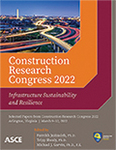Human-in-the-Loop Model Predictive Operation for Energy Efficient HVAC Systems
Publication: Construction Research Congress 2022
ABSTRACT
HVAC systems account for majority of energy consumption in buildings and play a vital role in energy efficiency and occupants’ comfort. Efficient control of HVAC systems could reduce energy consumption while maintaining occupants’ comfort at an acceptable level. Predictive control strategies that leverage the thermal capacity of buildings have been shown to be an effective approach in decreasing the energy consumption of buildings. One of the conventional methods in representing comfort in the formulation of predictive controllers is to consider a fixed temperature range as a constraint. However, this method does not account for differences in occupants’ thermal preferences. Therefore, in this paper, we have compared the performance of two model-predictive controllers in terms of energy consumption and thermal satisfaction: the first one is a conventional controller constrained by a fixed temperature range and the second proposed controller is constrained by information from personal comfort profiles. The controllers were formulated as optimization problems using multivariate regression for predictive modeling and genetic algorithm for optimization. To represent human thermal preferences, probabilistic comfort profiles of occupants were developed by utilizing real-world thermal votes. The performance of these controllers was evaluated in a residential building through EnergyPlus simulations for different multi-occupancy scenarios of one, two, and four occupants. The proposed MPC controller improves thermal satisfaction by 15% while increasing energy consumption by 4% on average.
Get full access to this article
View all available purchase options and get full access to this chapter.
REFERENCES
Carli, R., G. Cavone, S. Ben Othman, and M. Dotoli. (2020). “IoT Based Architecture for Model Predictive Control of HVAC Systems in Smart Buildings.” Sensors (Basel) 20(3).
Daum, D., F. Haldi, and N. Morel. (2011). “A personalized measure of thermal comfort for building controls.” Building and Environment 46(1): 3–11.
Ding, X., W. Du, and A. E. Cerpa. (2020). Mb2c. Proceedings of the 7th ACM International Conference on Systems for Energy-Efficient Buildings, Cities, and Transportation: 50–59.
Drgoňa, J., J. Arroyo, I. Cupeiro Figueroa, D. Blum, K. Arendt, D. Kim, E. P. Ollé, J. Oravec, M. Wetter, D. L. Vrabie, and L. Helsen. (2020). “All you need to know about model predictive control for buildings.” Annual Reviews in Control.
Hong, T., Y. Chen, X. Luo, N. Luo, and S. H. Lee. (2020). “Ten questions on urban building energy modeling.” Building and Environment 168.
Hu, M., F. Xiao, J. B. Jørgensen, and R. Li. (2019). “Price-responsive model predictive control of floor heating systems for demand response using building thermal mass.” Applied Thermal Engineering 153: 316–329.
Huang, S., Y. Lin, V. Chinde, X. Ma, and J. Lian. (2021). “Simulation-based performance evaluation of model predictive control for building energy systems.” Applied Energy 281.
Jazizadeh, F., A. Ghahramani, B. Becerik-Gerber, T. Kichkaylo, and M. Orosz. (2014). “Human-Building Interaction Framework for Personalized Thermal Comfort-Driven Systems in Office Buildings.” Journal of Computing in Civil Engineering 28(1): 2–16.
Jung, W., and F. Jazizadeh. (2019). “Comparative assessment of HVAC control strategies using personal thermal comfort and sensitivity models.” Building and Environment 158: 104–119.
Killian, M., and M. Kozek. (2016). “Ten questions concerning model predictive control for energy efficient buildings.” Building and Environment 105: 403–412.
Liu, S., S. Schiavon, H. P. Das, M. Jin, and C. J. Spanos. (2019). “Personal thermal comfort models with wearable sensors.” Building and Environment 162.
PNNL. “Residential Prototype Building Models, Available from https://www.energycodes.gov/development/residential.”
Ramos Ruiz, G., E. Lucas Segarra, and C. Fernández Bandera. (2018). “Model Predictive Control Optimization via Genetic Algorithm Using a Detailed Building Energy Model.” Energies 12(1).
Shaikh, P. H., N. B. M. Nor, P. Nallagownden, I. Elamvazuthi, and T. Ibrahim. (2014). “A review on optimized control systems for building energy and comfort management of smart sustainable buildings.” Renewable and Sustainable Energy Reviews 34: 409–429.
Van Hoof, J. (2008). “Forty years of Fanger’s model of thermal comfort: comfort for all?” Indoor air 18(3): 182–201.
West, S. R., J. K. Ward, and J. Wall. (2014). “Trial results from a model predictive control and optimisation system for commercial building HVAC.” Energy and Buildings 72: 271–279.
Yang, S., M. P. Wan, W. Chen, B. F. Ng, and S. Dubey. (2020). “Model predictive control with adaptive machine-learning-based model for building energy efficiency and comfort optimization.” Applied Energy 271.
Yao, Y., and D. K. Shekhar. (2021). “State of the art review on model predictive control (MPC) in Heating Ventilation and Air-conditioning (HVAC) field.” Building and Environment 200.
Yoon, J. H., R. Baldick, and A. Novoselac. (2014). “Dynamic Demand Response Controller Based on Real-Time Retail Price for Residential Buildings.” IEEE Transactions on Smart Grid 5(1): 121–129.
Yoon, J. H., R. Baldick, and A. Novoselac. (2016). “Demand response control of residential HVAC loads based on dynamic electricity prices and economic analysis.” Science and Technology for the Built Environment 22(6): 705–719.
Information & Authors
Information
Published In
History
Published online: Mar 7, 2022
Authors
Metrics & Citations
Metrics
Citations
Download citation
If you have the appropriate software installed, you can download article citation data to the citation manager of your choice. Simply select your manager software from the list below and click Download.
